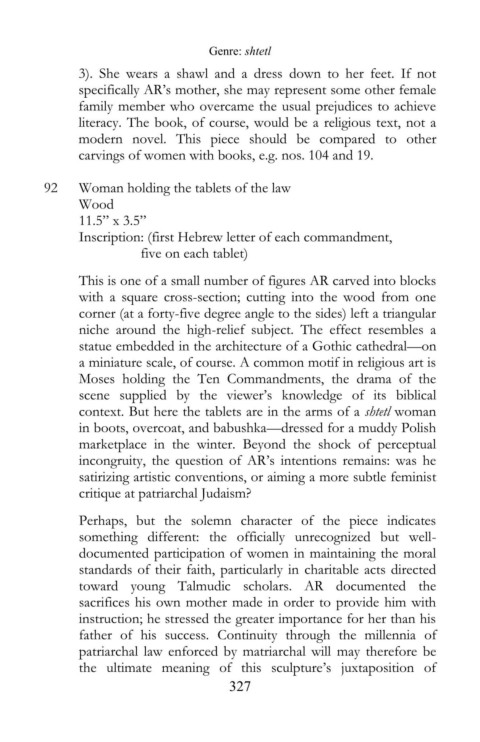Page 331 - The Legacy of Abraham Rothstein - text
P. 331
Genre: shtetl
3). She wears a shawl and a dress down to her feet. If not
specifically AR’s mother, she may represent some other female
family member who overcame the usual prejudices to achieve
literacy. The book, of course, would be a religious text, not a
modern novel. This piece should be compared to other
carvings of women with books, e.g. nos. 104 and 19.
92 Woman holding the tablets of the law
Wood
11.5” x 3.5”
Inscription: (first Hebrew letter of each commandment,
five on each tablet)
This is one of a small number of figures AR carved into blocks
with a square cross-section; cutting into the wood from one
corner (at a forty-five degree angle to the sides) left a triangular
niche around the high-relief subject. The effect resembles a
statue embedded in the architecture of a Gothic cathedral—on
a miniature scale, of course. A common motif in religious art is
Moses holding the Ten Commandments, the drama of the
scene supplied by the viewer’s knowledge of its biblical
context. But here the tablets are in the arms of a shtetl woman
in boots, overcoat, and babushka—dressed for a muddy Polish
marketplace in the winter. Beyond the shock of perceptual
incongruity, the question of AR’s intentions remains: was he
satirizing artistic conventions, or aiming a more subtle feminist
critique at patriarchal Judaism?
Perhaps, but the solemn character of the piece indicates
something different: the officially unrecognized but well-
documented participation of women in maintaining the moral
standards of their faith, particularly in charitable acts directed
toward young Talmudic scholars. AR documented the
sacrifices his own mother made in order to provide him with
instruction; he stressed the greater importance for her than his
father of his success. Continuity through the millennia of
patriarchal law enforced by matriarchal will may therefore be
the ultimate meaning of this sculpture’s juxtaposition of
327

